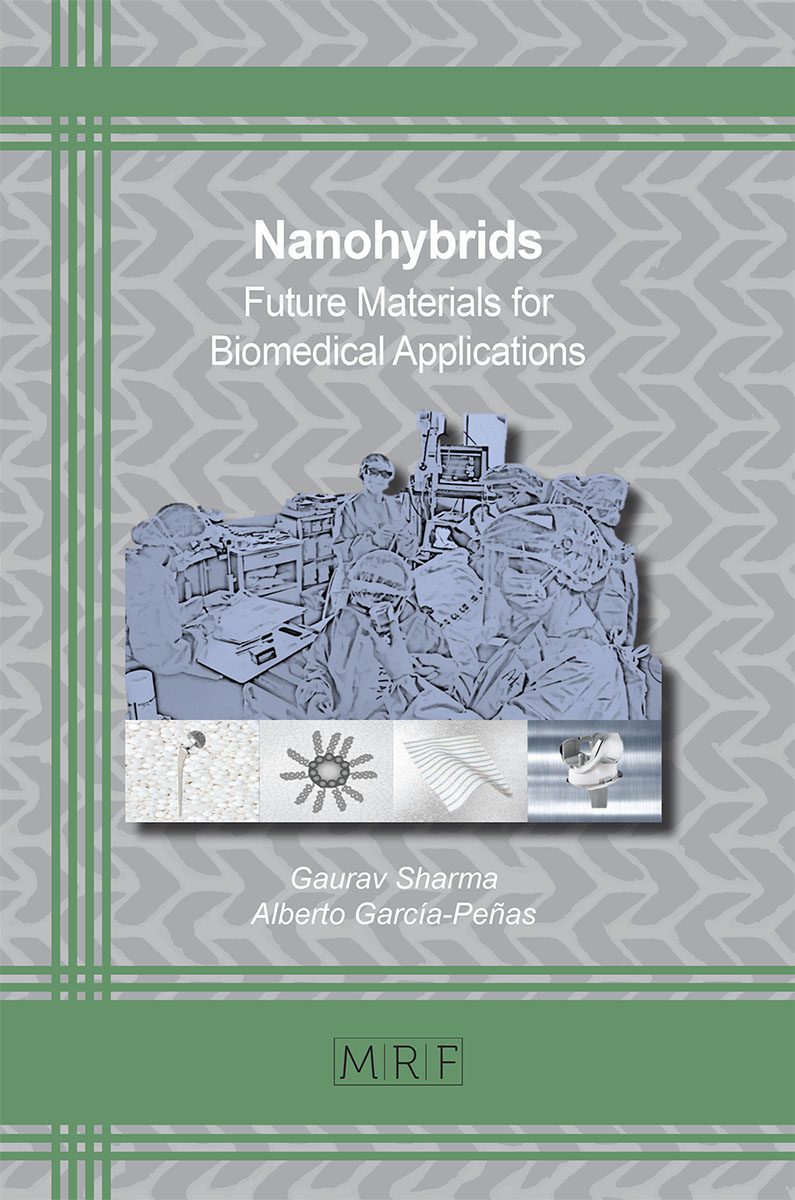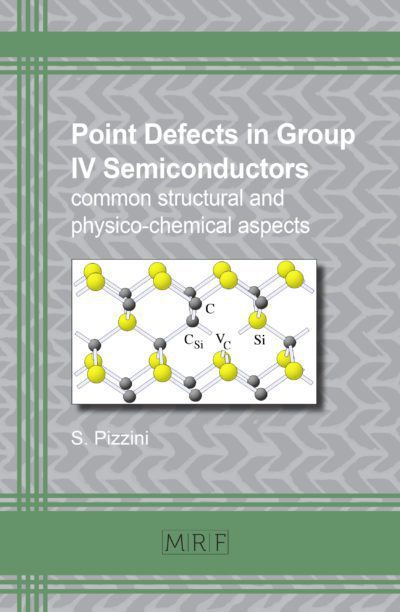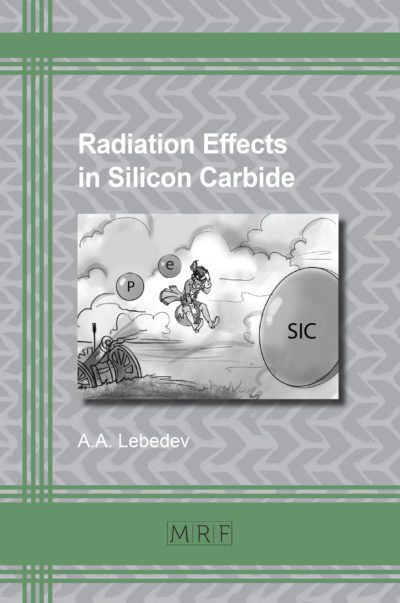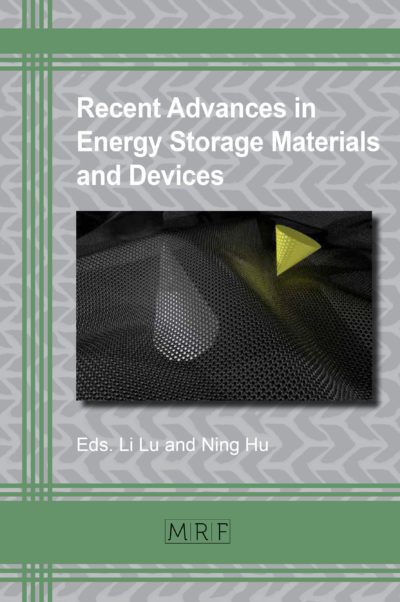Nanohybrids
Future Materials for Biomedical Applications
Eds. Gaurav Sharma and Alberto García-Peñas
Materials Research Foundations Vol. 87
Publication Date 2021, 278 Pages
Color Print ISBN 978-1-64490-106-9 (release date January 2021)
ePDF 978-1-64490-107-6
DOI: 10.21741/9781644901076
The book covers preparation, designing and utilization of nanohybrid materials for biomedical applications. These materials can improve the effectiveness of drugs, promote high cell growth in new scaffolds, and lead to biodegradable surgical sutures. The use of hybrid magneto-plasmonic nanoparticles may lead to non-invasive therapies. The most promising materials are based on silica nanostructures, polymers, bioresorbable metals, liposomes, biopolymeric electrospun nanofibers, graphene, and gelatin. Much research focuses on the development of biomaterials for cell regeneration and wound healing applications.
Keywords
Biomedical Materials, Cell Growth, Cell Regeneration, Wound Healing, Surgical Sutures, Non-invasive Therapies , Drug Transport, Tissue Engineering, Cardiovascular Implants, Fracture Repair Implants, Biodegradable Materials, Hybrid Magneto-plasmonic Nanoparticles, Silica Nanostructures, Polymers, Bioresorbable Metals, Liposomes, Biopolymeric Electrospun Nanofibers, Graphene, Gelatin-based Hydrogels
flyer
Table of Contents
Hybrid Magneto-Plasmonic Nanoparticles in Biomedicine: Fundamentals, Synthesis and Applications
J.G. Ovejero, P. Herrasti
Biomaterials for Cell Regeneration
A. Saravanan, P. Senthil Kumar, R.V. Hemavathy, S. Jeevanantham
Biosensors Based on Graphene
Shalini Muniandy, Chin Wei Lai, Thiruchelvi Pulingam, Bey Fen Leo
Hybrid Materials based on Silica Nanostructures for Biomedical Scaffolds (Bone Regeneration) and Drug Delivery
Mojdeh Rahnama Ghahfarokhi, Jhaleh Amirian
Nanohybrids for Wound Healing Application
A. Saravanan, P. Senthil Kumar, R. Jayasree, S. Jeevanantham
Bioresorbable Metals for Cardiovascular and Fracture Repair Implants
S.C. Cifuentes, V. San-Miguel, Y. Wang, A. García-Peñas
Application of Biopolymeric Electrospun Nanofibers in Biological Science
Mehdihasan I. Shekh, Jhaleh Amirian, Gisya Abdi, Dijit M. Patel, Bing Du
Development of Hybrid Materials Based on Polymers for Biomedical Applications: A Short Introduction
A. García-Peñas, S.C. Cifuentes, Y. Wang, V. San-Miguel
Role of Liposomes Composite as Drug Transport Mechanism
P. Senthil Kumar, P.R. Yaashikaa
Gelatin Based Hydrogels for Tissue Engineering and Drug Delivery Applications
Jhaleh Amirian, Gisya Abdi, Mehdihasan I. Shekh, Ehsan Amel Zendehdel, Bing Du, Florian J. Stadler
About the Editors
Dr. Gaurav Sharma research activity started in 2009 at Shoolini University (India) as master of philosophy student, and then, he continued his research work as PhD student. He is working on the preparation and characterization of diverse multifunctional nanomaterials, and their composites, specially focused for their potential applications in environmental remediation and biological field. At School of chemistry, Shoolini University (India) he carried out diverse research lines, interrelated to each other based on synthesis and characterization of nanocomposites, hydrogels, bi and trimetallic nanoparticles, ion exchangers, drug delivery nanomaterials, adsorbents and photocatalysts etc. Moreover, he performed and taught different courses as nanochemistry, polymer chemistry, spectroscopy and natural products, among others. On the other hand, he supervised 5 Master of Philosophy, and more than 25 Master and Bachelors students. He established collaborative research with various groups in countries such as Finland, Saudi Arabia, China, Spain, Vietnam and South Africa. In this context, he was invited as visiting research professor from University of KwaZuklu-Natal (South Africa) in 2017 and 2019. In 2017, he joined as postdoctoral fellow at college of materials science and engineering, Shenzhen University. He got a project from China postdoctoral science foundation in 2018. He is a reviewer of more than 36 journals.
The outcome of his research work includes more than 130 publications-SCI, in reputed journals such as Renewable and Sustainable Energy Reviews, Chemical Engineering Journal, Journal of Cleaner Production, Carbohydrate Polymers, ACS Applied Materials and Interfaces, Journal of Hazardous Materials and International Journal of Biological Macromolecules etc. He contributed to 9 book chapters and edited 5 books.
Furthermore, the impact of his research has been highlighted too by fact, that he has been recognized as Web of Science Highly Cited Researcher-2020. For instance, few of his research paper in International Journal of Biological Macromolecules, Process Safety and Environmental Protection, Materials Science and Engineering: C; Journal of King Saud University-Science, Journal of Photochemistry and Photobiology A: Chemistry; are most cited articles published since 2017.
His h-index is 47, citations: 5050 (web of science). He is Associate Editor of International Journal of Environmental Science and Technology (Springer); Chemical Papers (Springer). Editorial Board member of Current Organic Chemistry, Innovations in Corrosion and Materials Science, Journal of Nanostructure in Chemistry (Springer), Nanotechnology for Environmental Engineering(Springer), Letters in Applied NanoBioScience etc, and Academic Editor of Journal of Nanomaterials and Advances in Polymer Technology.
Dr. Alberto García Peñas is Assistant Professor in the Department of Materials Science and Engineering at University Carlos III of Madrid (Spain), where he is working on smart polymers, composites, blends and biopolymers. Importance of this work is endorsed by numerous articles in high impact journals, and participation in different international and national conferences. Furthermore, quality of his global research is reflected in the numerous awards that this Thesis received: the “2015 Student Innovation Award” international award by multinational Borealis to the best Doctoral Thesis worldwide in the area of polyolefins; Awards to Best Thesis granted by Specialized Groups in Polymers and in Calorimetry and Thermal Analysis, both groups from the Royal Spanish Societies of Chemistry and Physics. Merits reached during the 2015-2016 academic year were also recognized by the Council for Scientific Research. Nowadays, he has 10 awards and honors which were collected along these years.
He is Executive Board Member of Network of Researchers China-Spain. He organized the First Meeting of Ibero-American Researchers and a EURAXESS Researchers’ Night in Shenzhen (China). Dr. García-Peñas is leading research works and seminars associated with education and training for Chemical Engineers and Chemists.

































